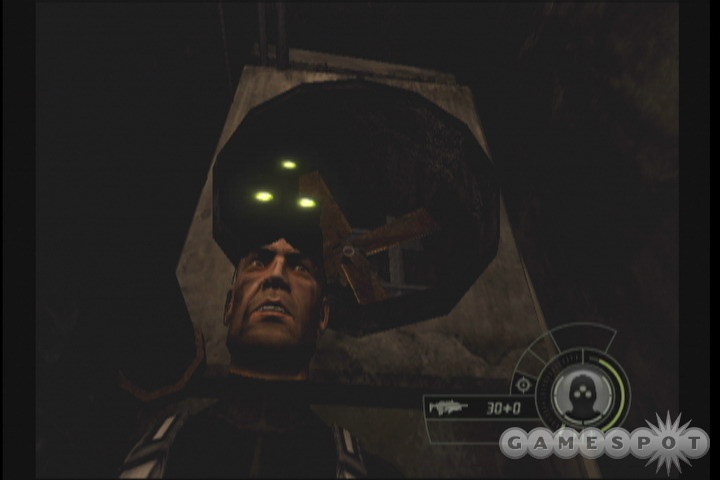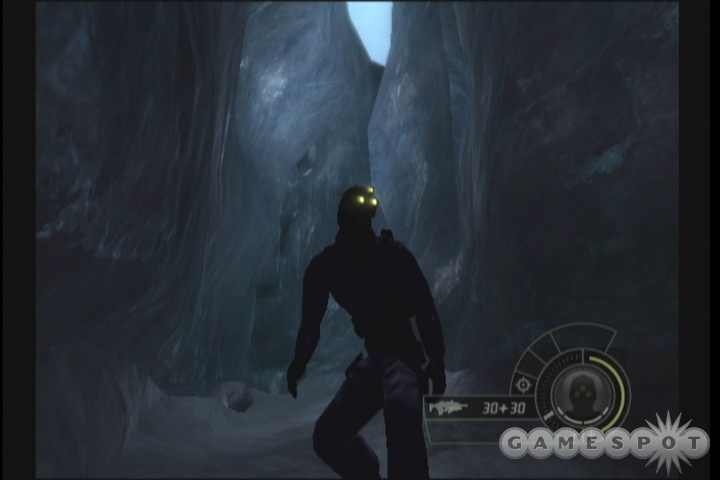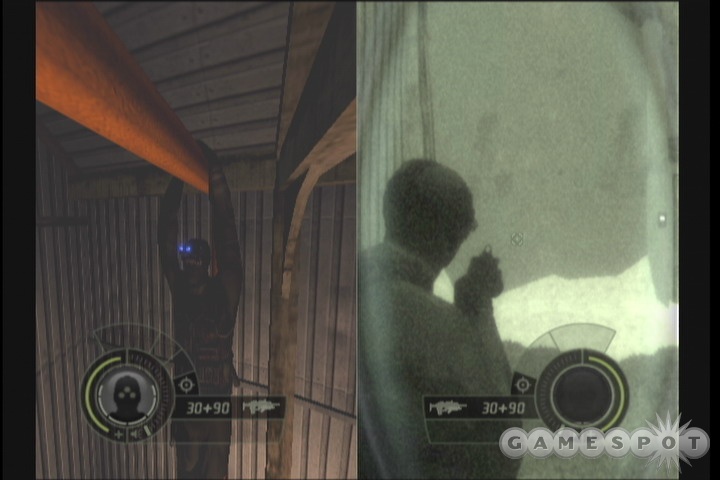Gruff, tireless agent Sam Fisher and his top-secret missions in all the Splinter Cell games have helped to popularize a style of play that blends a lot of sneaking around with quick, short doses of extreme force. The fourth Splinter Cell game in as many years, Double Agent for the Xbox and PlayStation 2 delivers some exciting results through a familiar formula. It doesn't look quite as flashy, but overall this is as impressive a game as the version released shortly beforehand for the Xbox 360. There's a lot to this package, between the challenging and replayable solo campaign, more than a dozen cooperative missions designed for two players, and a variety of all-new competitive multiplayer modes. But the biggest and strangest surprise is that the content of these versions of the game is completely different from the Xbox 360 version, such that Splinter Cell fans really owe it to themselves to play both the 360 version and one of these.

Of course, most Splinter Cell fans will probably never get the memo. It's only reasonable to expect that the content of Splinter Cell Double Agent would be roughly similar on all platforms, since that's just how it tends to be when a game is released for a variety of platforms at about the same time. Besides, each version of Double Agent shares the same exact title, box cover, and premise. But instead, the similarity between the Xbox 360 version of Double Agent and the old-console versions on the Xbox and PS2 goes no deeper than the basic synopsis of Double Agent's storyline and an underlying gameplay formula that's been intact in every Splinter Cell game.
In the solo campaign, you play as Sam Fisher as he tries to infiltrate a terrorist organization to find out what makes it tick, same as on the Xbox 360. But the missions in these other versions of the game are completely different from the missions in the Xbox 360 game. The story is told differently and in a much better way, not a one of the gameplay changes in the Xbox 360 version are in here, and the multiplayer modes are unique to these versions of the game. They're different than the multiplayer modes from the last two Splinter Cell games, and they're equally different from the multiplayer mode from Double Agent for the 360.
Since this is the fourth time that Splinter Cell is appearing on the Xbox and PS2, you won't be too surprised by the overall presentation or gameplay if you've played any of the previous titles. There's still a marked difference in visual quality between the Xbox and PS2 versions, with the Xbox version sporting substantially more detail in the characters and environments and better lighting. However, the PS2 version looks much improved compared with previous Splinter Cell games for the PS2, and looks quite good overall. It's strangely brighter than the Xbox version in a lot of spots, probably because darker areas in the PS2 version use a noticeable dithering effect, which probably helps keep the frame rate up at the expense of richer colors. The Xbox 360 version does look much better than both of these, but as mentioned, these versions do make up for this predictable shortcoming in other, significant ways. Also, Double Agent sounds excellent on both the Xbox and PS2, despite a lot of recycled sound effects from older games. Michael Ironside again provides Fisher his distinctive voice, plus many more great lines of dialogue than in Double Agent's Xbox 360 counterpart. The game's also got a musical score that epitomizes a spy thriller such as this.
On the Xbox 360, Splinter Cell Double Agent's story has an interesting hook but leaves much to be desired in terms of plot and character development. On the Xbox and PS2, it's still not the greatest story ever told or anything, but there's substantially more and better dialogue, stronger characters, and a better ending--yet the same basic plot and main characters. Plot holes from the Xbox 360 version are plugged. For example, while it's inexplicable why Fisher would get to use his government-issue experimental rifle while working for terrorists in that version, on the Xbox and PS2 we learn that Fisher's commanding officer plants the gun by tricking the terrorists into believing he's an arms dealer. The relationship between Fisher and the one female member of the terrorist group is also revealed in greater detail on the Xbox and PS2, making Fisher's moral dilemma around how to deal with her and the rest of his mission seem much more interesting. In fact, the entire trust system--one of the new features in Double Agent--is handled completely differently in these versions of the game. Fisher still must try to balance his level of trust with both the terrorist group and the National Security Agency, but the conflicting choices he'll have to make when forced to follow contradictory orders aren't the same in these versions, nor are the consequences.

Despite a new look to the onscreen interface and the ability to work with computer-controlled allies in a few sequences, the underlying gameplay in the solo campaign is nearly identical to that of last year's Splinter Cell Chaos Theory. This means you'll be spending most of your time skulking through shadows, sneaking up on foes and putting them in a vice grip, or using either lethal or nonlethal close-combat attacks to take them out of commission. As always, Fisher must stand perfectly still for his aim to be true, preventing this from being a run-and-gun style of game. However, it can still be satisfying to squeeze off single, silenced shots to down unsuspecting enemies from afar. Fisher will also do plenty of climbing and crawling through this game's complex, multistory environments. And while it's yours to decide whether to sneak past foes, knock them out, or do them in, and also whether to take on various optional objectives, ultimately the solo missions are linear in nature. So Double Agent's mission design really is quite similar to that of the last Splinter Cell game, and it also recycles the same animations and sound effects, creating a similar overall presentation. The game does have a different feel than its predecessors, though.
Occasionally you'll be forced to make a moral choice of some sort, such as early on when you've got a chance to kill a man whom one of your terrorist "friends" wants dead. This just comes down to a button press, and the consequences aren't usually significant, but it can still be fun to play through sequences multiple times to see how the mission objectives finally pan out. There are also three different difficulty settings to choose from, and even at the normal setting (the easiest of the three), the level of challenge is still significant. You can save your progress at anytime, and you'll want to, since you'll need to sneak past dozens of accurate, deadly foes in any given mission. Enemy behavior isn't terribly complex, but they use cover well and their bullets hurt a lot. Sometimes enemy resistance is so dense that Double Agent boils down to feeling like trial-and-error, but usually you have a variety of options for dealing with enemies or navigating the levels. So when the going gets tough, you'll sooner just rethink your strategy than get frustrated.

The Xbox 360 version of Double Agent slightly strayed from the Splinter Cell norm by featuring a variety of daytime missions, as well as timed missions in the terrorist base. On the Xbox and PS2, the levels are conventionally dark like in past Splinter Cell games, and the timed missions aren't there. That means, since the trust system isn't really that big of a change, fans of Chaos Theory's campaign can expect more of the same this time around. However, the more-engaging storyline helps make this particular campaign better than that of the previous Splinter Cell titles. Like the previous games, expect to put in a good 10 hours or so before you reach Double Agent's dramatic conclusion, which will be affected by some of the key choices you make.
If you've had your fill of the solo missions, Splinter Cell Double Agent offers a complete set of two-player cooperative missions as well as plenty of competitive multiplayer modes to keep you busy for much longer. The co-op missions in these versions of the game hark back to the compelling but underdeveloped co-op gameplay introduced in Chaos Theory, whereas on the Xbox 360, the co-op missions are just a multiplayer variant against computer-controlled opponents. This means you'll undertake story-driven missions from the perspective of other agents in the employ of Third Echelon, the same organization that pays Fisher's bills. These missions tend to be loosely related to the solo campaign, which makes them add an interesting layer to the story.
What's more, you and your partner will get to use a variety of double-team moves, like using one another as a human ladder. Some cool new co-op moves are in here, such as the ability to cooperatively interrogate foes for when a little intimidation is not enough. The co-op missions still feel rough around the edges, as it's possible for both players to instantly fail if just one player makes a wrong step off a ledge, for instance. But this mode can still be a lot of fun, and it's also worth noting that there are nearly four times more co-op missions here as were bundled with Chaos Theory. Split-screen co-op play is available on both the Xbox and PS2, but only the Xbox version features cooperative play online--another reason why the Xbox version is definitely the one to get if you have the choice.
The competitive multiplayer mode in the Xbox and PS2 versions of Double Agent is a surprising departure from the innovative but rather complicated spies-versus-mercenaries mode introduced two years ago. Namely, it's not spies-versus-mercenaries anymore, but just spies-versus-spies in a battle between Third Echelon and a rival organization, Upsilon. This is inherently somewhat disappointing, since the way in which the previous games--and the Xbox 360 version of Double Agent--pitted fast-moving spies against heavily armed mercenaries was truly unique. For better or worse, the multiplayer now feels more familiar and faster paced. Though the spies play a lot like Fisher from the solo missions, they've got some of their own moves. And unlike the 360 version's multiplayer spies, these guys all pack assault rifles, so they can fight just fine. One particularly interesting twist to this new multiplayer game design is how close combat battles between spies are resolved. When one attacks another in close quarters, the first player to press a button that randomly appears onscreen instantly kills his opponent, turning close encounters into lightning-fast battles of reflexes (and, perhaps, Internet connection speeds).

Multiplayer is solid on both the Xbox and PS2, but it's easier to get into a match on Xbox Live, and the Xbox version supports six players in a match, while the PS2 version supports only four. To help make up for this, the PS2 version features a couple of exclusive multiplayer variants, though they're not so special that Xbox owners will miss them. Other than that, the multiplayer experience is similar in both versions. There are more than half a dozen multiplayer variants, in stark contrast to the one core multiplayer mode of the Xbox 360 version. These include your typical deathmatch and team deathmatch, as well as some capture-the-flag and king-of-the-hill-style options. A variety of densely packed maps are available as well, and the gunplay and acrobatics that typically unfolds in them can be pretty exciting. Even though it's not as original as the multiplayer modes from other Splinter Cell games, Double Agent's multiplayer is still distinctive and worth checking out.
It's a shame that the Xbox 360 version of Splinter Cell Double Agent, being the most high-tech, is liable to get most of the attention. That's not because the Xbox 360 version isn't the best overall, since it probably is. But there are a lot of legitimately different, legitimately interesting things about the older-console versions of this game, which Splinter Cell fans simply shouldn't miss out on. Double Agent on the older consoles has a lot of its own great missions, gameplay, and plot points that you won't get from the 360 version alone, and they retail for less. The Xbox version particularly stands out, thanks to its online co-op mode and relatively impressive graphics, but the PS2 version is no slouch, either. And if you do get a chance to experience both versions of Double Agent's story, in the end, it might make a strange kind of sense. There are two sides to every story, after all.